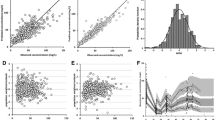Abstract
Purpose
The study characterizes the long-term pharmacokinetics (PK) following last dose of bevacizumab as adjuvant therapy in patients with resected stage II and III colon carcinoma in a Phase III clinical study (AVF3077s).
Methods
Patients in AVF3077s received bevacizumab (5 mg/kg every 2 weeks) as adjuvant therapy for 1 year. Following the last dose bevacizumab concentration, data at 3 and 6 months were used to characterize long-term bevacizumab PK based on the population-modeling approach.
Results
The long-term bevacizumab PK were consistent with previously reported results based on short-term bevacizumab PK. The clearance (CL), central volume of distribution (V 1), intercompartmental clearance (Q), and the peripheral volume of distribution (V 2) were 214 mL/day, 2,830 mL, 636 mL/day, and 2,490 mL, which correspond to a disposition and elimination half-life of 1.33 and 19.1 days, respectively. The empirical Bayes estimates of median post-treatment bevacizumab drug levels at 3 and 6 months were 6.14 and 0.23 μg/mL, respectively. For test covariates, the change in CL and V 1 of bevacizumab was less than 20 % of the typical value. Body weight is the important covariate explaining the inter-individual variability on CL and V 1.
Conclusions
Long-term bevacizumab PK in this study was predictable based on short-term PK data from metastatic settings in other tumor types. An exploratory analysis demonstrated no apparent association of the tested covariates with bevacizumab PK. Further, the extended serum persistence of bevacizumab following last dose should be considered in clinical study designs and post-treatment evaluations that may be affected by bevacizumab.



Similar content being viewed by others
References
Planchard D (2011) Bevacizumab in non-small-cell lung cancer: a review. Expert Rev Anticancer Ther 11(8):1163–1179
Koukourakis GV, Sotiropoulou-Lontou A (2011) Targeted therapy with bevacizumab (Avastin) for metastatic colorectal cancer. Clin Transl Oncol 13(10):710–714
Escudier B, Albiges L (2011) Vascular endothelial growth factor-targeted therapy for the treatment of renal cell carcinoma. Drugs 71(9):1179–1191
Chamberlain MC (2011) Bevacizumab for the treatment of recurrent glioblastoma. Clin Med Insights Oncol 5:117–129
Van Meter ME, Kim ES (2010) Bevacizumab: current updates in treatment. Curr Opin Oncol 22(6):586–591
Rivera F, López-Tarruella S, Vega-Villegas ME, Salcedo M (2009) Treatment of advanced pancreatic cancer: from gemcitabine single agent to combinations and targeted therapy. Cancer Treat Rev 35(4):335–339
Mulder K, Scarfe A, Chua N, Spratlin J (2011) The role of bevacizumab in colorectal cancer: understanding its benefits and limitations. Expert Opin Biol Ther 11(3):405–413
Ulahannan SV, Brahmer JR (2011) Antiangiogenic agents in combination with chemotherapy in patients with advanced non-small cell lung cancer. Cancer Invest 29(4):325–337
Jakobsen JN, Hasselbalch B, Stockhausen MT, Lassen U, Poulsen HS (2011) Irinotecan and bevacizumab in recurrent glioblastoma multiforme. Expert Opin Pharmacother 12(5):825–833
Pietzner K, Richter R, Chekerov R, Erol E, Oskay-Özcelik G, Lichtenegger W, Sehouli J (2011) Bevacizumab in heavily pre-treated and platinum resistant ovarian cancer: a retrospective study of the North-Eastern German Society of Gynaecologic Oncology (NOGGO) Ovarian Cancer Study Group. Anticancer Res 31(8):2679–2682
Park MS, Ravi V, Araujo DM (2010) Inhibiting the VEGF-VEGFR pathway in angiosarcoma, epithelioid hemangioendothelioma, and hemangiopericytoma/solitary fibrous tumor. Curr Opin Oncol 22(4):351–355
Gordon MS, Margolin K, Talpaz M, Sledge GW Jr, Holmgren E, Benjamin R, Stalter S, Shak S, Adelman D (2001) Phase I safety and pharmacokinetic study of recombinant human anti-vascular endothelial growth factor in patients with advanced cancer. J Clin Oncol 19(3):843–850
Lu JF, Bruno R, Eppler S, Novotny W, Lum B, Gaudreault J (2008) Clinical pharmacokinetics of bevacizumab in patients with solid tumors. Cancer Chemother Pharmacol 62(5):779–786
Zhi J, Chen E, Major P, Burns I, Robinson B, McKendrick J, Rittweger K, Abt M, Goldstein D (2011) A multicenter, randomized, open-label study to assess the steady state pharmacokinetics of bevacizumab given with either XELOX or FOLFOX-4 in patients with metastatic colorectal cancer. Cancer Chemother Pharmacol 68(5):1199–1206
Avastin Biological License Application (BLA No. 125085) (2003) Genentech, Inc. South San Francisco
Joshi A, Bauer R, Kuebler P, White M, Leddy C, Compton P, Garovoy M, Kwon P, Walicke P, Dedrick R (2006) An overview of the pharmacokinetics and pharmacodynamics of efalizumab: a monoclonal antibody approved for use in psoriasis. J Clin Pharmacol 46(1):10–20
Joos B, Trkola A, Kuster H, Aceto L, Fischer M, Stiegler G, Armbruster C, Vcelar B, Katinger H, Günthard HF (2006) Long-term multiple-dose pharmacokinetics of human monoclonal antibodies (MAbs) against human immunodeficiency virus type 1 envelope gp120 (MAb 2G12) and gp41 (MAbs 4E10 and 2F5). Antimicrob Agents Chemother 50(5):1773–1779
Fasanmade AA, Adedokun OJ, Olson A, Strauss R, Davis HM (2010) Serum albumin concentration: a predictive factor of infliximab pharmacokinetics and clinical response in patients with ulcerative colitis. Int J Clin Pharmacol Ther 48(5):297–308
Kim J, Bronson CL, Hayton WL, Radmacher MD, Roopenian DC, Robinson JM, Anderson CL (2006) Albumin turnover: FcRn-mediated recycling saves as much albumin from degradation as the liver produces. Am J Physiol Gastrointest Liver Physiol 290:G352–G360
Kim J, Hayton WL, Robinson JM, Anderson CL (2007) Kinetics of FcRn-mediated recycling of IgG and albumin in human: Pathophysiology and therapeutic implications using a simplified mechanism-based model. Clin Immunol 122:146–155
Acknowledgments
The authors would like to thank Anshin Biosolutions for their editorial support and assistance with preparing this manuscript for publication.
Conflict of interest
The study was sponsored by Hoffmann-La Roche. Jing Li, Manish Gupta, Denise Jin, Yan Xin, Jennifer Visich and David Allison are employees of Genentech, Inc.
Author information
Authors and Affiliations
Corresponding author
Rights and permissions
About this article
Cite this article
Li, J., Gupta, M., Jin, D. et al. Characterization of the long-term pharmacokinetics of bevacizumab following last dose in patients with resected stage II and III carcinoma of the colon. Cancer Chemother Pharmacol 71, 575–580 (2013). https://doi.org/10.1007/s00280-012-2031-7
Received:
Accepted:
Published:
Issue Date:
DOI: https://doi.org/10.1007/s00280-012-2031-7




